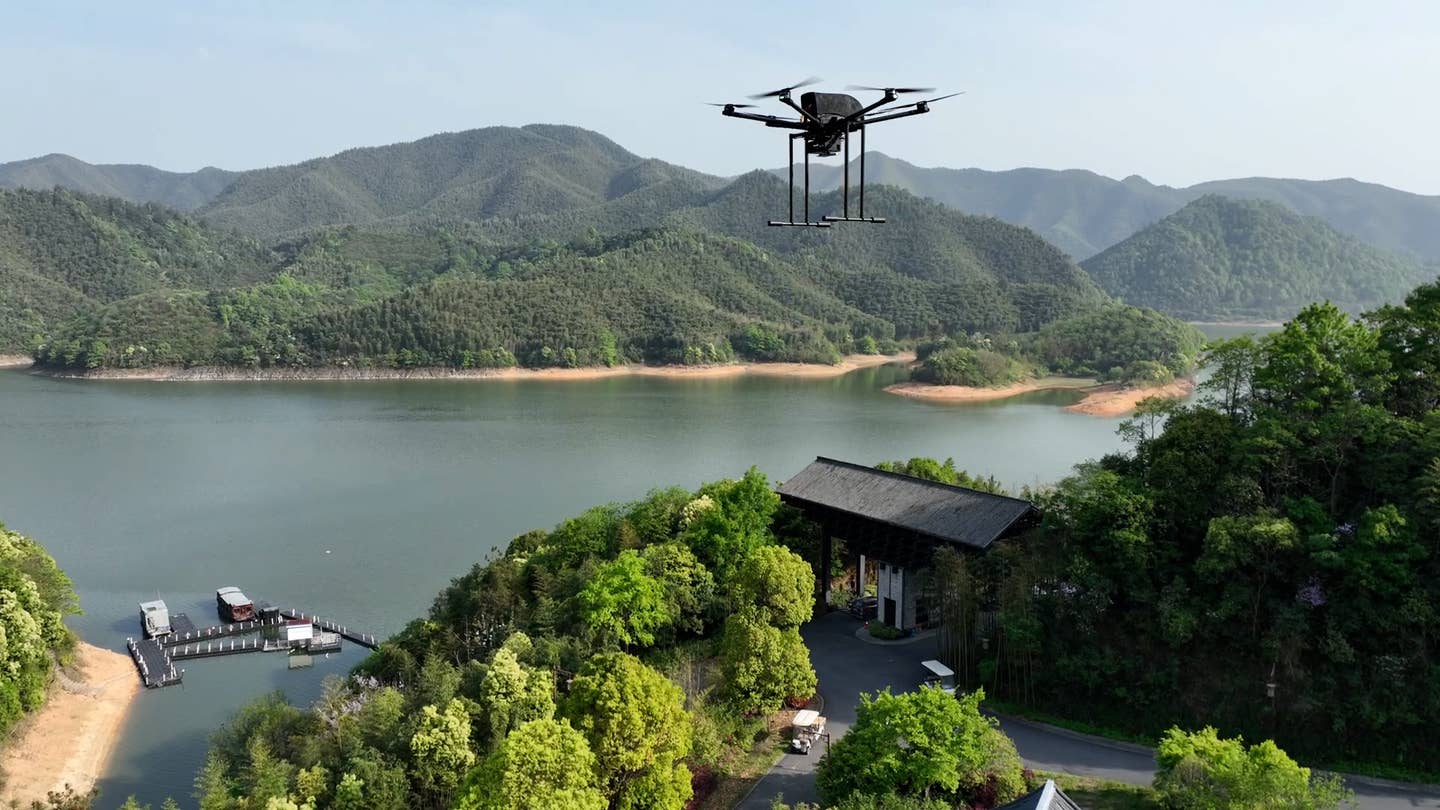A2Z Drone Delivery Unveils Revamped Last-Mile Drone That Can Fly in Rain
The new RDST Longtail comes in standard and premium configurations, each equipped with the company’s RDS2 delivery system.

An early look at the new RDST Longtail in action. [Courtesy: A2Z Drone Delivery]
Drones don’t like piña coladas (obviously), and they really don’t like getting caught in the rain. At least, most don’t.
A2Z Drone Delivery’s latest model is an exception. The company this week unveiled a revamped, second-generation version of its classic RDST design, the Longtail. Available in standard and premium configurations, the drone comes with expanded range, a factory-integrated autonomous delivery system, and—most importantly—the ability to cut through rain.
“Many of the upgrades included in this second generation RDST have been made in response to customer feedback on capabilities they need to deploy for missions in inclement weather, and the platform has proven robust during testing in rain conditions,” said Aaron Zhang, founder and CEO of A2Z.
The redesigned Longtail is an off-the-shelf, ready-to-fly unmanned aerial vehicle (UAV) built for last-mile delivery. Billed as a “heavy-lift” model, its maximum payload of 19.5 pounds pales in comparison to cargo drones from companies such as Elroy Air or Dronamics. But in the world of last-mile delivery—the final stage of the supply chain—most drones carry half that weight.
Longtail’s release comes just months after the May launch of A2Z’s RDSX Pelican, a long-range model capable of carrying payloads up to 11 pounds over distances as far as 25 sm (21.7 nm).
“The RDST Longtail is further democratizing commercial drone delivery by allowing businesses of any kind to quickly and easily launch a drone logistics operation from delivering parts to offshore energy platforms, to deploying live-saving medical equipment to first responders right on scene,” said Zhang.
Customers can pay extra to integrate Longtail’s hexarotor design with the company’s Rapid Delivery System 2 (RDS2), a winch and tether mechanism. RDS2 is both drone- and payload-agnostic—it can be attached to any drone and pick up any shipper’s boxes.
When the drone reaches its destination, RDS2 allows it to lower payloads on a tether from as high as 100 feet, directly into the customer’s backyard or front step. Keeping the drone at that height avoids any noise and privacy concerns. And with the addition of an auto-release mechanism, it won’t need to wait for the recipient to step outside.
In standard configuration, Longtail is now available starting at $20,000. The standard model can fly an 11-pound payload almost seven sm (6 nm) at a cruise speed of 38 knots. According to A2Z, that makes it ideal for local food and parcel delivery, emergency medical delivery, offshore logistics, search and rescue, water sampling, and more.
But for a rainproof glass fiber exterior, customers will need to upgrade to the premium Longtail model, which comes integrated with RDS2 and boasts an extended 16 sm (13.9 sm) range and a battery quick-release system. The ability to fly in the rain expands potential use cases for the premium model, while the battery quick-release mechanism places a cap on downtime.
“In upgrading our off-the-shelf RDST platform, we’ve streamlined the overall design and upgraded the propulsion system, but the most sought-after upgrade from customers has been the rainproofing built into our new RDST Longtail Premium edition,” said Zhang.
Users can also upgrade the premium edition for mission-specific needs. They can add dual 4G LTE connectivity, a parachute system, and even extra auto-release hooks for RDS2. However, the extra features come at a cost—the premium Longtail starts at $27,000.
The standard and premium configurations each offer a large cargo bay (18 inches by 18 inches by 14 inches) and an 18.5-mile unobstructed transmission range. Both meet the FAA’s 55-pound maximum takeoff weight requirement and are Remote ID compliant, with factory-integrated beacons.
Each also comes with the portable A2Z Ground Control Station and the Q Ground Control (QGC) mission planning software, which can conduct preplanned, automated deliveries without the need to land the drone. Like automated dispatch systems do for trucking, QGC figures to reduce operating costs for last-mile drone deliveries.
So far, a prototype Longtail has already logged 500 flight hours making daily residential parcel deliveries outside Shanghai, China, near A2Z’s test facility.
It’s unclear whether A2Z plans to phase out its previous RDST design in favor of Longtail. But on the company’s website, clicking on the RDST product page now redirects to the RDS2, suggesting the first-generation model may be discontinued.
Like this story? We think you'll also like the Future of FLYING newsletter sent every Thursday afternoon. Sign up now.

Subscribe to Our Newsletter
Get the latest FLYING stories delivered directly to your inbox






